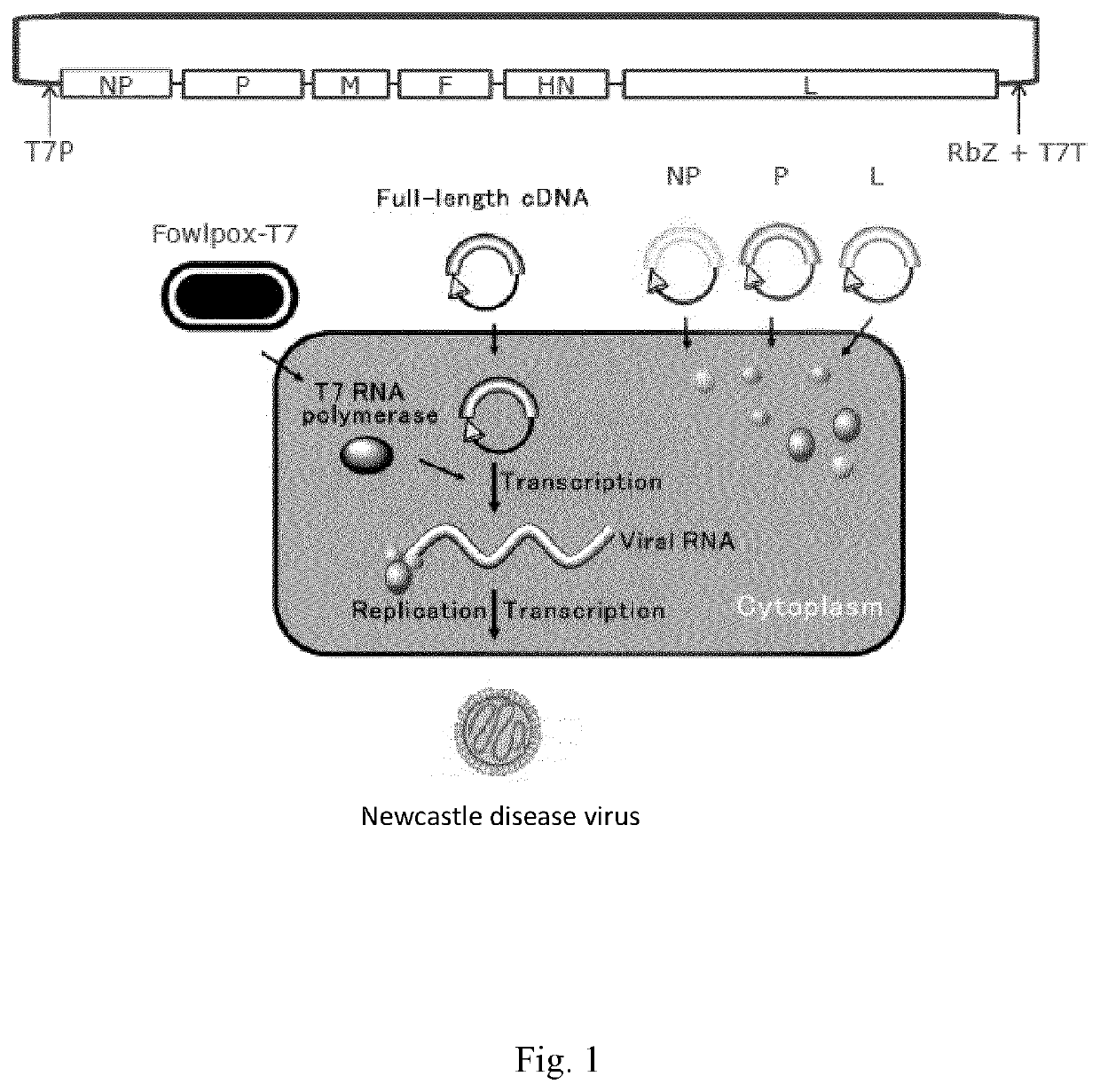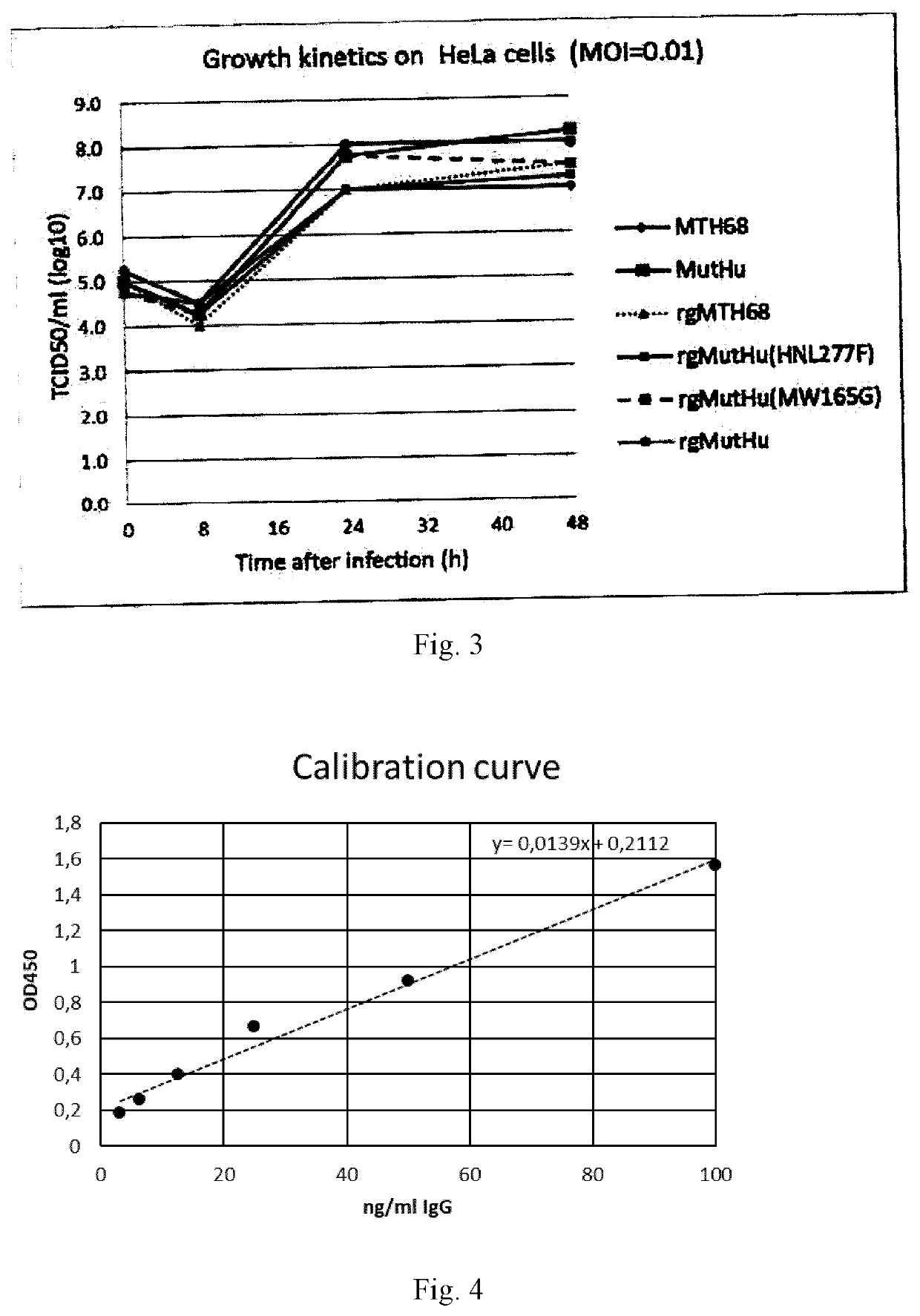Recombinant oncolytic newcastle disease viruses with increased activity
a technology increased activity, which is applied in the field of recombinant oncolytic newcastle disease viruses with increased activity, can solve the problems of poor prognosis of neoplasm, affecting egg production and quality, and up to 90% mortality
- Summary
- Abstract
- Description
- Claims
- Application Information
AI Technical Summary
Benefits of technology
Problems solved by technology
Method used
Image
Examples
example 1
Nucleotide Sequence Analysis of Mutant NDV-Mut HN(F277L) / M(G165W)
[0240]We identified a spontaneous mutant of an oncolytic NDV strain MTH-68 / H (Csatary et al., 1999, Anticancer Res. 19:635-638.; further called MTH68). The replication capacity of the mutant strain (designated NDV-Mut HN(F277L) / M(G165W) in a variety of human neoplastic cell lines, as well as autologous primary tumors, is greatly enhanced as compared to the original MTH-68 / H strain (also referred to as MTH68 strain). We analyzed its nucleotide sequence and found that, compared to MTH68, NDV-HN(F277L) / M(G165W) has two nucleotide mutations, one leading to an amino acid substitution in the M protein (G165W) and the other in the HN protein (F277L).
example 2
A Reverse Genetics System that Allows Genetic Modification of NDV-Strains
[0241]2.1 Reverse Genetics
[0242]In order to be able to genetically modify the genome of an RNA virus such as NDV, a manipulatable genetic system must be developed that uses a copy of the full viral RNA (vRNA) genome in the form of DNA. This full-length cDNA is amenable to genetic modification by using recombinant DNA techniques. The authentic or modified cDNA can be converted back into vRNA in cells, which in the presence of the viral replication proteins results in the production of a new modified infectious virus. Such ‘reverse genetics systems’ have been developed in the last few decades for different classes of RNA viruses. This system enables the rapid and facile introduction of mutations and deletions and the insertion of a transgene transcriptional unit, thereby enabling the changing of the biological properties of the virus.
[0243]Reverse genetics systems for several NDV strains, including lentogenic as ...
example 3
Identify Whether One or Both of the Amino Acid Substitutions in Mut HN(F277L) / M(G165W) are Responsible for the Difference in Growth Kinetics Between Mut HN(F277L) / M(G165W) and the Parent Strain MTH68
[0258]3.1 Growth Kinetics in HeLa Cells
[0259]The rescued rg-viruses (Table 1) as well as the original Mut HN(F277L) / M(G165W) and MTH68 viruses were used to determine their growth-kinetics in HeLa cells. Briefly, 4×106 HeLa cells were seeded in 25 cm2 cell culture flasks and grown overnight. The cells were infected using a MOI of 0.01 (i.e., 1 infectious virus particle per 100 cells), and at 8, 24 and 48 hours after infection the virus titer in the supernatant was determined by end-point titration on QM5 cells.
[0260]The data (FIG. 3) indicate that strains Mut HN(F277L) / M(G165W) and rgMut HN(F277L) / M(G165W) yield at least 10-fold higher virus titers than MTH68. Furthermore, the data indicate that the mutation at amino acid position 277 in the HN gene is responsible for this effect. The M m...
PUM
| Property | Measurement | Unit |
|---|---|---|
| green fluorescent | aaaaa | aaaaa |
| fluorescent | aaaaa | aaaaa |
Abstract
Description
Claims
Application Information
 Login to View More
Login to View More - R&D
- Intellectual Property
- Life Sciences
- Materials
- Tech Scout
- Unparalleled Data Quality
- Higher Quality Content
- 60% Fewer Hallucinations
Browse by: Latest US Patents, China's latest patents, Technical Efficacy Thesaurus, Application Domain, Technology Topic, Popular Technical Reports.
© 2025 PatSnap. All rights reserved.Legal|Privacy policy|Modern Slavery Act Transparency Statement|Sitemap|About US| Contact US: help@patsnap.com



